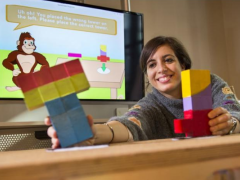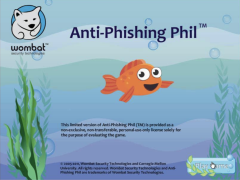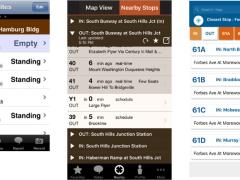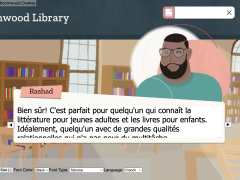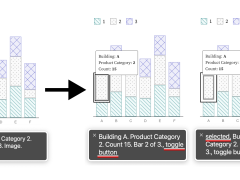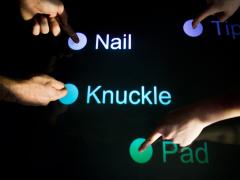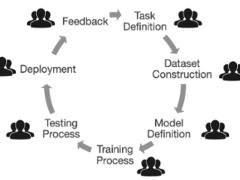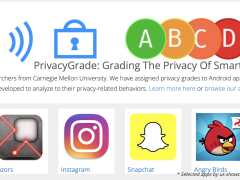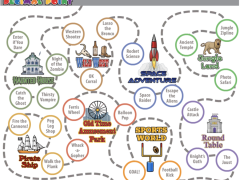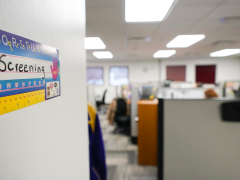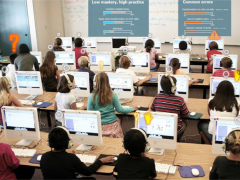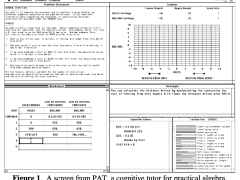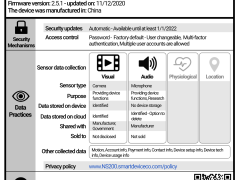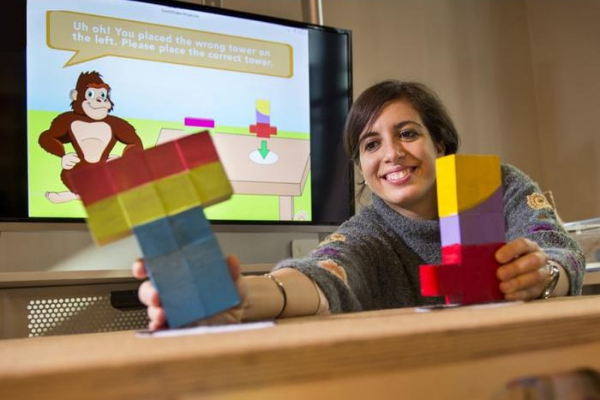NoRILLA Interactive Mixed-Reality Science for Kids
Impact: We invented the Intelligent Science Station
Our mixed-reality stations bridge the physical and virtual worlds.
As children do hands-on experiments with physical objects in the real world, a friendly on-screen gorilla character powered by AI and computer vision provides personalized interactive feedback as the learner makes discoveries. Millions of children and families across the US are learning more science and improving their critical thinking skills after predicting, observing and explaining experiments with our AI-based Intelligent Science Stations.
We invented Intelligent Science Stations powered by AI to improve children's inquiry-based STEM learning.
This work led to...
- Creating the intelligent science station, NoRILLA. Our Novel Research-based Intelligent Lifelong Learning Apparatus (NoRILLA) is a patented, mixed-reality system that improves children's inquiry-based STEM learning by 5 times compared to other screen-based technologies, while also increasing engagement.
- New applications beyond the earthquake table. In one NoRILLA experiment, children build brick towers to see what style is less likely to fall in an earthquake, and then with interactive AI guidance and feedback from the system’s gorilla character, the table shakes the bricks to test the learner’s hypothesis. In addition to earthquakes, we are expanding the system to explore other content areas, such as ramps and balance scales.
- Installations in many museums and schools. Millions of children and families have interacted with our installations at places such as the Carnegie Science Center, Children's Museum of Atlanta, Please Touch Museum in Philadelphia, Children's Discovery Museum in San Jose, Muse Knoxville, and after school programs.
- An extensive partnering STEM curriculum. The curriculum we built for NoRILLA is being used in many schools and afterschool programs as well.
- A feature in an international exhibit. NoRILLA was chosen as 1 of 6 exhibits from around the world to showcase the benefits of AI at the Caixa Forum Agora AI Museum (Valencia, Spain).
Supported by: This work has been funded by multiple NSF grants including NSF AISL (Advancing Informal STEM Learning), NSF DRK-12 (Discovery Research Pre K-12), and NSF PFI: AIR-TT (Partnerships for Innovation: Accelerating Innovation Research - Technology Translation), as well as other foundation grants such as PNC Grow up Great, Grable Foundation, McElhattan Foundation, and EQT Foundation.
Timing: The research started around 2012 and is ongoing.
Related work:
- "Active learning: 'Hands-on' meets 'minds-on'” in Science Magazine
- "Active learning is about more than hands-on: A mixed-reality AI system to support STEM education" in the International Journal of Artificial Intelligence in Education
- “Intelligent science exhibits: Transforming hands-on exhibits into mixed-reality learning experiences” in the Journal of the Learning Sciences
- the Norilla website
Researchers: Nesra Yannier, Ken Koedinger, Scott Hudson and team
Research Areas: Learning Sciences and Educational Technologies, AR/VR/XR
Looking at Additional HCII Impacts...
NoRILLA Interactive Mixed-Reality Science for Kids
Our novel, mixed-reality intelligent science stations bridge the physical and virtual worlds. Millions of children and families across the US are learning more science and improving their critical thinking skills after predicting, observing and explaining experiments with our patented system at their schools and museums.
Protecting Millions of People from Phishing Scams
We studied the social aspects of phishing attacks and protected millions of people through education and training. This work led to new educational methods to raise awareness, effective anti-phishing warnings, and algorithmic detection of phishing attacks.
Tiramisu Supported Public Transit Riders and Research
Years before the public transit buses in Pittsburgh had GPS location trackers, we were exploring how riders could be the co-creators of mobile transit info. During this 10 year research project, this app made it easier for travelers with disabilities to engage in opportunistic travel and benefited 75,000 unique transit riders.
Developing Novel Interfaces for Livestreamed Gaming
Livestream gaming viewers are limited in the ways they can participate, but this team found that designing a better experience for livestreams has a variety of benefits for audiences worldwide.
Creating Accessible Visualizations with Chartability
The Chartabilty framework has empowered people around the world to recognize the parts of a data visualization that produce barriers for people with disabilities. It has contributed to dozens of design languages, visualization guides, accessibility curriculum at universities, and the data journalism seen on news websites.
TapSense Improved Touch Detection on Millions of Smartphones
We trained smartphones to reliably detect four different touchscreen inputs – for example, a tap by a finger pad as compared to a knuckle – which created opportunities for new interactions and features.
Supporting Developers So They Can Build More Responsible AI
We conducted the first studies with industry practitioners to understand the challenges they face when building responsible AI systems. Our tools and methods are now supporting developers around the world.
Grading Your Smartphone Apps on Their Privacy Practices
We created a model that analyzed over 1 million smartphone apps on their privacy and data collection practices, and then assigned them a public-facing privacy grade. This easy-to-follow grading system raised public awareness and led to improved privacy practices from several app developers.
Improved Math Mastery with the Decimal Point Game
We explored the learning analytics behind our digital learning game to see how student learning responds to curriculum changes to the game. Over the past 10 years, over 1,500 students have benefited from the Decimal Point game and curriculum materials.
Understanding the Impacts of AI in Child Welfare
We conducted the first field studies to understand how child welfare workers incorporate AI-based recommendations into their decision-making, which had far-reaching policy impacts.
Designing Teacher-AI Collaboration Systems
Hundreds of elementary and middle school students across the US have learned more as a result of our work on real-time, teacher-AI collaboration systems in K-12 classrooms.
Millions Learned More Math with Our AI Tutor
Millions of middle school and high school students across the US have learned more math as a result of our decades of work with AI-based cognitive tutoring systems.
Human-Centered Privacy for the Internet of Things
As more gadgets become “smart” things and the Internet of Things (IoT) expands to tens of billions of connected devices, we want consumers to be aware of what their devices are doing with their personal data.
Zensors Turns Cameras Into Smart Sensors
In one application installed at the Pittsburgh International Airport in 2019, Zensors use existing cameras as powerful general-purpose sensors to provide wait time estimates for the security line, which benefits almost 10M PIT travelers per year.
Accessible Visualization Tooling with Data Navigator
A visual labeled as “an image of a bar chart” or that requires a mouse hover to display important info does not support all users. We created the Data Navigator system to give developers a flexible foundation for designing and building more inclusive data experiences.


